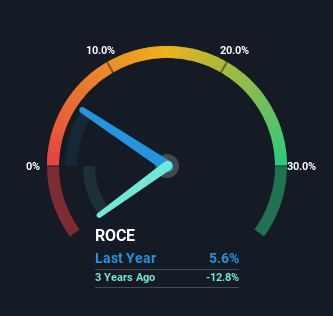- Hong Kong
- /
- Specialty Stores
- /
- SEHK:1817
Investors Could Be Concerned With Mulsanne Group Holding's (HKG:1817) Returns On Capital

When it comes to investing, there are some useful financial metrics that can warn us when a business is potentially in trouble. Businesses in decline often have two underlying trends, firstly, a declining return on capital employed (ROCE) and a declining base of capital employed. Ultimately this means that the company is earning less per dollar invested and on top of that, it's shrinking its base of capital employed. On that note, looking into Mulsanne Group Holding (HKG:1817), we weren't too upbeat about how things were going.
What Is Return On Capital Employed (ROCE)?
If you haven't worked with ROCE before, it measures the 'return' (pre-tax profit) a company generates from capital employed in its business. To calculate this metric for Mulsanne Group Holding, this is the formula:
Return on Capital Employed = Earnings Before Interest and Tax (EBIT) ÷ (Total Assets - Current Liabilities)
0.056 = CN¥69m ÷ (CN¥3.0b - CN¥1.8b) (Based on the trailing twelve months to December 2023).
Thus, Mulsanne Group Holding has an ROCE of 5.6%. Ultimately, that's a low return and it under-performs the Specialty Retail industry average of 10%.
View our latest analysis for Mulsanne Group Holding

While the past is not representative of the future, it can be helpful to know how a company has performed historically, which is why we have this chart above. If you're interested in investigating Mulsanne Group Holding's past further, check out this free graph covering Mulsanne Group Holding's past earnings, revenue and cash flow.
So How Is Mulsanne Group Holding's ROCE Trending?
In terms of Mulsanne Group Holding's historical ROCE movements, the trend doesn't inspire confidence. About five years ago, returns on capital were 41%, however they're now substantially lower than that as we saw above. On top of that, it's worth noting that the amount of capital employed within the business has remained relatively steady. Companies that exhibit these attributes tend to not be shrinking, but they can be mature and facing pressure on their margins from competition. If these trends continue, we wouldn't expect Mulsanne Group Holding to turn into a multi-bagger.
On a separate but related note, it's important to know that Mulsanne Group Holding has a current liabilities to total assets ratio of 59%, which we'd consider pretty high. This effectively means that suppliers (or short-term creditors) are funding a large portion of the business, so just be aware that this can introduce some elements of risk. Ideally we'd like to see this reduce as that would mean fewer obligations bearing risks.
The Bottom Line On Mulsanne Group Holding's ROCE
In summary, it's unfortunate that Mulsanne Group Holding is generating lower returns from the same amount of capital. This could explain why the stock has sunk a total of 86% in the last three years. Unless there is a shift to a more positive trajectory in these metrics, we would look elsewhere.
Mulsanne Group Holding does have some risks though, and we've spotted 3 warning signs for Mulsanne Group Holding that you might be interested in.
While Mulsanne Group Holding isn't earning the highest return, check out this free list of companies that are earning high returns on equity with solid balance sheets.
If you're looking to trade Mulsanne Group Holding, open an account with the lowest-cost platform trusted by professionals, Interactive Brokers.
With clients in over 200 countries and territories, and access to 160 markets, IBKR lets you trade stocks, options, futures, forex, bonds and funds from a single integrated account.
Enjoy no hidden fees, no account minimums, and FX conversion rates as low as 0.03%, far better than what most brokers offer.
Sponsored ContentNew: Manage All Your Stock Portfolios in One Place
We've created the ultimate portfolio companion for stock investors, and it's free.
• Connect an unlimited number of Portfolios and see your total in one currency
• Be alerted to new Warning Signs or Risks via email or mobile
• Track the Fair Value of your stocks
Have feedback on this article? Concerned about the content? Get in touch with us directly. Alternatively, email editorial-team (at) simplywallst.com.
This article by Simply Wall St is general in nature. We provide commentary based on historical data and analyst forecasts only using an unbiased methodology and our articles are not intended to be financial advice. It does not constitute a recommendation to buy or sell any stock, and does not take account of your objectives, or your financial situation. We aim to bring you long-term focused analysis driven by fundamental data. Note that our analysis may not factor in the latest price-sensitive company announcements or qualitative material. Simply Wall St has no position in any stocks mentioned.
About SEHK:1817
Mulsanne Group Holding
An investment holding company, engages in the design, marketing, and sale of apparel products for men in Mainland China and Macau.
Fair value low.
Market Insights
Community Narratives



